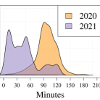Identifying regional variation in place visit behavior during a global pandemic
DOI:
https://doi.org/10.5311/JOSIS.2021.23.170Keywords:
visit duration, place type, time spent, COVID-19, pandemic, regional variabilityAbstract
The emergence of the SARS-CoV-2 virus in 2019 lead to a global pandemic that altered the activity behavior of most people on our planet. While government regulations and public concern modified visitation patterns to places of interest, little research has examined the nuanced changes in the length of time someone spends at a place, nor the regional variability of these changes. In this work, we examine place visit duration in four major U.S. cities, identify which place types saw the largest and smallest changes, and quantify variation between cities. Furthermore, we identify socio-economic and demographic factors that contribute to changes in visit duration and demonstrate the varying influence of these factors by region. The results of our analysis indicate that the pandemic's impact on visiting behavior varies between cities, though there are commonalities found in certain types of places. Our findings suggest that places of interest within lower income communities experienced less change in visit duration than others. An increase in the percentage of younger, Black or Hispanic populations within a community also resulted in a smaller decrease in visit duration than in other communities. These findings offer insight into the factors that contribute to changes in visiting behavior and the resilience of communities to a global pandemic.

Downloads
Published
Versions
- 2022-01-05 (3)
- 2021-12-28 (2)
- 2021-12-24 (1)
Issue
Section
License
Copyright (c) 2021 Grant McKenzie, Kevin M. Mwenda

This work is licensed under a Creative Commons Attribution 3.0 Unported License.
Articles in JOSIS are licensed under a Creative Commons Attribution 3.0 License.
